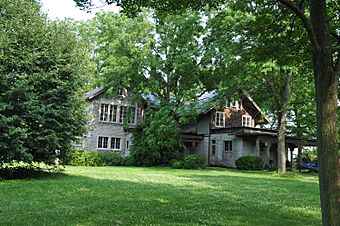Linwood (York, New York) facts for kids
Quick facts for kids |
|
|
Linwood
|
|
 |
|
| Location | 1912 York Rd., York, New York, U.S. |
|---|---|
| Area | 350 acres (140 ha) |
| Built | 1899 |
| Architect | multiple |
| Architectural style | Romanesque |
| NRHP reference No. | 97001493 |
| Added to NRHP | December 15, 1997 |
Linwood Gardens is a special historic place in York, New York. It is also known as the Gratwick Estate. This large property covers about 350 acres (1.4 square kilometers).
At its heart is a beautiful summer house. Around it, you'll find lovely gardens, peaceful woods, and open meadows. Linwood Gardens is most famous for its amazing collection of tree peonies. These special flowers were gathered and grown by William H. Gratwick III and Nassos Daphnis between the 1940s and 1960s.
Because of its history and beauty, Linwood Gardens was added to the National Register of Historic Places in 1997.
Contents
The Gratwick Family and Linwood Gardens
The Gratwick family played a big part in creating and caring for Linwood Gardens. Let's learn about some key members of this family.
William H. Gratwick, Sr.: A Business Leader
William Henry Gratwick, Sr. (1839-1899) was a successful businessman. He was born in Albany and later moved to Buffalo, New York, in 1877. There, he started a large lumber company. His company owned forests in Michigan and used six ships to move timber across the Great Lakes.
The Gratwick family lived in a grand home in Buffalo. When William H. Gratwick, Sr. passed away in 1899, his wife, Martha Weare Gratwick, made an important donation. She gave $25,000 to Dr. Roswell Park, who had treated her husband. This gift helped start the Roswell Park Cancer Institute, which was the first center in the world focused only on cancer research.
William H. Gratwick, Jr.: Creating the Estate
William H. Gratwick, Jr. (often called "Harry") inherited money from his father. While he helped with the family lumber business, he was more interested in other things. He worked on real estate projects and was a Vice-President for the New York State Board of Charities.
In 1900, Harry bought a farm in Livingston County, New York. He wanted to build a summer home there, which was a popular idea for wealthy families at the time. Construction started soon after. Harry worked with famous architects to design the summer house. He also hired a landscape architect named Thomas Fox to plan the roads and gardens. These plans were made between 1901 and 1910, and much of their work can still be seen today. In 2015, the gardens received an award for their historic landscape.
When Harry died in 1934, his son, William H. Gratwick III, took over the estate.
William H. Gratwick III: The Peony Master
William H. Gratwick III (known as "Bill") was a man of many talents. He enjoyed breeding special kinds of sheep and training Arabian horses for riding and driving. He also loved carriages, making sculptures, and helping with local plays and music shows.
But his most lasting contribution is the amazing collection of Japanese and hybrid tree peonies at Linwood Gardens. Many important types of these flowers were grown and developed right there, starting in the 1940s.
In 1938, Bill met Arthur P. Saunders, a chemistry professor who was also a leading expert in growing new types of tree peonies. Saunders had created over 300 kinds of herbaceous peonies and more than 70 kinds of tree peonies, including unique yellow ones. Bill Gratwick worked with Saunders for over ten years. He brought over 100 special Japanese tree peony plants and 500 seeds from Japan to add to Saunders' collection. After Saunders passed away in 1953, Bill continued his work. He eventually introduced twelve of his own new peony types.
Nassos Daphnis: Artist and Peony Hybridizer
Nassos Daphnis (1914-2010) was an American painter born in Greece. He met Bill Gratwick in the late 1930s and learned about the world of tree peonies. For most summers of his life, Nassos visited Linwood Gardens. He became very involved in creating new types of tree peonies and also painted them.
He introduced 48 new peony types, which came in shades of pink, yellow, white, mauve, and maroon. He named these new flowers after figures from Greek mythology. The tree peony collection at Linwood Gardens still shows the beautiful flowers he developed there, honoring his legacy.
Linwood Music School and York Opera Company
Harriet L. Saltonstall Gratwick (1907-1999) was married to William H. Gratwick III. She loved music and started the Linwood Music School in 1948. The school ran until 1963.
Harriet had studied at the Eastman School of Music. She ran the summer music school at the Gratwick Estate. Students could take classes in singing, piano, organ, cello, and other instruments. Children performed in choir concerts in the gardens. Professional musicians from Rochester and Buffalo were invited to give free concerts for the community. Mrs. Gratwick also helped create the York Opera Company, which put on community shows of Gilbert and Sullivan musicals.



